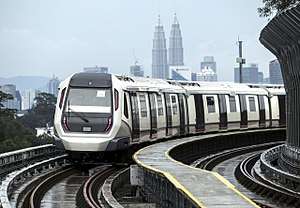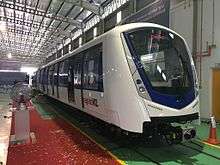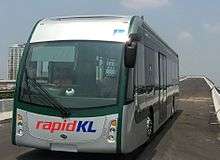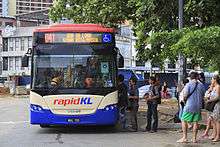Rapid KL
|
| |
| Overview | |
|---|---|
| Owner | Prasarana Malaysia Berhad |
| Locale | Klang Valley, Malaysia |
| Transit type |
|
| Number of lines | |
| Number of stations |
|
| Daily ridership |
|
| Website |
myrapid |
| Operation | |
| Began operation | 16 December 1995 |
| Operator(s) |
Rapid Rail Sdn Bhd Rapid Bus Sdn Bhd |
| Technical | |
| System length |
|
| Track gauge | 1,435 mm (4 ft 8 1⁄2 in) standard gauge |
Rapid KL (styled as rapidKL; ) is a public transportation system built by Prasarana Malaysia and operated by its subsidiaries, covering the Kuala Lumpur and Klang Valley areas.
The acronym stands for Rangkaian Pengangkutan Intergrasi Deras Kuala Lumpur. The Rapid KL public transport system is one component of Klang Valley Integrated Transit System.
History
Public transport restructuring
The need for Kuala Lumpur's public transport system to be revamped became apparent once the city's LRT lines began commercial operations and it was determined that ridership had been much lower than anticipated. This caused correspondingly lower than expected revenue levels, and the two LRT concessionaires, Sistem Transit Aliran Ringan Sdn Bhd (STAR-LRT) and Projek Usahasama Transit Ringan Automatik Sdn Bhd (PUTRA-LRT), could not repay their commercial loans. The 1997 Asian financial crisis aggravated the situation, and by November 2001, the two companies owed a combined total of RM5.7 billion. The Government of Malaysia's Corporate Debt Restructuring Committee (CDRC) stepped in to restructure the debts of the two LRT companies.
The bus service in Kuala Lumpur was also facing problems with lower ridership due to an increase in private car usage and a lack of capital investments. The two new bus consortia formed in the mid 1990s to consolidate all bus services in Kuala Lumpur, 'Intrakota Komposit and Cityliner, began facing financial problems. Intrakota had reportedly accumulated losses amounting to RM450 million from the 1997 financial crisis until Prasarana Malaysia took over in 2003.
With decreased revenues, the bus operators could not maintain their fleets, much less invest in more buses. Frequencies and service deteriorated as buses began breaking down, and ridership suffered as a result. Public transport usage in the Klang Valley area dropped to about 16% of all total trips.
Improvement steps







Since taking over the LRTs and bus network, Prasarana has taken steps to improve services.
- Increasing LRT capacity:Prasarana issued tenders for the purchase of new LRT rolling stock to increase carrying capacity, including 35 new train sets for the Kelana Jaya Line in October 2006 and October 2007. The trains were expected to be operational by September 2009. On 27 July 2009, Malaysian Prime Minister Najib Razak announced that the 35 new four-car trains would be operational by end-2012.[1]
- Boosting bus fleet:As most of the Rapid KL buses inherited were old and poorly maintained, the immediate concern was to get more buses on the road. In 2005, the government promised 200 new Rapid KL buses.
- Increasing bus routes:Prasarana introduced several new routes to cover previously unserved areas.
- Scheduled bus services: Rapid Bus introduced scheduled services for 16 Rapid KL bus routes which were not heavily utilised. For the first time in Malaysia, expected bus arrival times and timetables were posted at bus stops along routes. However, the bus stop timetables as well as the myrapid website has since been removed due to the inability of services to reliably adhere to these schedules. This was primarily caused by problems such as traffic congestion and an insufficient number of serviceable buses.
- Common monthly passes for both LRT and buses: For the first time commuters were offered monthly passes which could be used on both LRTs and buses, helping to enhance the integration of the public transport system.
- Common signage for all three LRT lines: The renaming of Putra-LRT and Star-LRT along with the changing of its signage helped to enhance integration of the previously unconnected systems.
- Common Ticketing System: Touch 'n Go could be used in all Rapid KL buses and rail lines
- Revamp of Rapid KL bus network: Prasarana scrapped the old Intrakota and Cityliner routes it inherited and introduced three types of bus services: City shuttles (BANDAR), trunk buses (UTAMA), local shuttles (TEMPATAN) and express buses (EKSPRES). City shuttles will operate within Kuala Lumpur's central business district while trunk buses will link hubs at the edge of the CBD with suburban transportation hubs. At these suburban hubs, local shuttles will radiate out from rail-based public transport stations and fan out to residential areas. Express buses provide non-stop point-to-point travel to specific destinations.
Rapid KL system network
Rail
The entire Rapid KL rail network operated by Rapid Rail Sdn Bhd is 151.1 km long and has 116 stations. These trains can travel up to 80 km/h. In 2008, these rail networks carried a total of over 350,000 passengers daily.[2]
Bus
The entire Rapid KL bus network operated by Rapid Bus Sdn Bhd and is also one of the largest stage bus operators in the Klang Valley, along with Transnasional. Currently, there are 98 stage bus routes and 39 feeder bus services which operate from LRT stations. The bus routes operated by Rapid Bus were previously operated by'Intrakota Komposit Sdn Bhd, a subsidiary of DRB-Hicom Bhd; and Cityliner Sdn Bhd, a subsidiary of Park May Bhd. In 2008, Rapid Bus carried around 390,000 passengers daily.[2]
Current services
| Code | Line | Stations | Length | Began operation | Termini | ||
|---|---|---|---|---|---|---|---|
| Ampang Line | 16 Dec 1996 | SP1 AG1 Sentul Timur | AG18 Ampang | ||||
| Sri Petaling Line | 11 Jul 1998 | AG1 SP1 Sentul Timur | SP31 KJ37 Putra Heights | ||||
| Kelana Jaya Line | 1 Sep 1998 | KJ1 Gombak | KJ37 SP31 Putra Heights | ||||
| KL Monorail | 31 Aug 2003 | MR1 KL Sentral Monorail | MR11 AG3 SP3 Titiwangsa | ||||
| Sungai Buloh–Kajang Line | 16 Dec 2016 | SBK1 KA08 Sungai Buloh | SBK35 KB06 Kajang | ||||
| BRT Sunway Line | 2 Jun 2015 | SB1 KD08 Setia Jaya | SB7 KJ31 USJ7 | ||||
| TOTAL | [Note 1] | ||||||
Future service
| Code | Line | Status | Planned open |
Stations | Length (km) |
Terminus | |
|---|---|---|---|---|---|---|---|
| Bandar Utama–Klang Line | Under construction | 31 August 2020 | 25 | 36 | Bandar Utama | Johan Setia | |
| Sungai Buloh–Serdang–Putrajaya Line | Under construction | Phase 1: July 2021 Phase 2: 2022 | 36 | 52.2 | Kwasa Damansara Kampung Batu | Kampung Batu Putrajaya | |
| Circle Line | Shelved | TBA | 52 | 40.6 | Ampang | Sentul Timur | |
Notes
- ↑ Counting interchange stations only once: Titiwangsa, Masjid Jamek, Hang Tuah, Maluri, Chan Sow Lin, Putra Heights, USJ7 and Pasar Seni. KL Sentral (Kelana Jaya Line and KL Monorail) & Bukit Bintang (KL Monorail and Sungai Buloh–Kajang Line) are not the actual interchange station despite the similar name. There is paid-to-paid integration between Merdeka (Sungai Buloh–Kajang Line) and Plaza Rakyat (Ampang Line/Sri Petaling Line) stations, but they are operationally and structurally separate stations.
References
- ↑ Nik Anis & Dharmender Singh (28 July 2009). "Targets set for the six Key Result Areas". The Star. Archived from the original on 31 July 2009.
- 1 2 "Penumpang Rapid KL naik mendadak". Utusan Malaysia. 9 July 2008. Retrieved 9 July 2008.
- 1 2 "Kelana Jaya Line". Prasarana Malaysia. Archived from the original on 30 March 2014. Retrieved 12 June 2014.
- 1 2 "KL Monorail Line". Prasarana Malaysia. Archived from the original on 30 March 2014. Retrieved 12 June 2014.
- 1 2 Sim Leoi Leoi (11 December 2016). "MRT first phase opens on Friday". The Star.